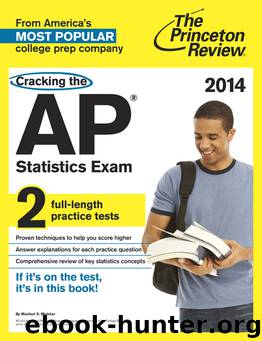Cracking the AP Statistics Exam, 2014 Edition by Princeton Review

Author:Princeton Review [Review, The Princeton]
Language: eng
Format: epub
ISBN: 978-0-8041-2430-0
Publisher: Random House Information Group
Published: 2013-10-14T16:00:00+00:00
For example, to estimate the difference in the proportion of women graduating with a degree in engineering at two major universities in Alabama, we could use the difference in those proportions computed from randomly selected samples of engineering students from each of these universities.
SAMPLING DISTRIBUTION OF A STATISTIC
As seen from these examples, the point estimate statistic is a function of random variables. Therefore, it is a random variable itself. Different samples will result in different estimates. How close or how far can these estimates be from the true value? We can answer this question by studying the distribution of the estimates. The sampling distribution of a statistic is the distribution of estimates (values taken by the statistic) from all possible samples of the same size from the same population.
Example 1: Suppose a student is interested in estimating p, the probability of getting heads when a penny is tossed. Suppose she tosses a penny 50 times and gets 24 heads. This sample of 50 tosses gives her an estimated probability () of = 0.48. So the student decides to see what happens if she repeats the experiment. The histogram and the table on the next page summarize the results of 100 such experiments, each of 50 tosses:
Table 1: Distribution of P(Heads) estimated from 50 tosses
Download
This site does not store any files on its server. We only index and link to content provided by other sites. Please contact the content providers to delete copyright contents if any and email us, we'll remove relevant links or contents immediately.
| Biomathematics | Differential Equations |
| Game Theory | Graph Theory |
| Linear Programming | Probability & Statistics |
| Statistics | Stochastic Modeling |
| Vector Analysis |
Modelling of Convective Heat and Mass Transfer in Rotating Flows by Igor V. Shevchuk(6209)
Weapons of Math Destruction by Cathy O'Neil(5784)
Factfulness: Ten Reasons We're Wrong About the World – and Why Things Are Better Than You Think by Hans Rosling(4458)
Descartes' Error by Antonio Damasio(3141)
A Mind For Numbers: How to Excel at Math and Science (Even If You Flunked Algebra) by Barbara Oakley(3082)
Factfulness_Ten Reasons We're Wrong About the World_and Why Things Are Better Than You Think by Hans Rosling(3029)
TCP IP by Todd Lammle(2987)
Applied Predictive Modeling by Max Kuhn & Kjell Johnson(2867)
Fooled by Randomness: The Hidden Role of Chance in Life and in the Markets by Nassim Nicholas Taleb(2837)
The Tyranny of Metrics by Jerry Z. Muller(2821)
The Book of Numbers by Peter Bentley(2745)
The Great Unknown by Marcus du Sautoy(2518)
Once Upon an Algorithm by Martin Erwig(2459)
Easy Algebra Step-by-Step by Sandra Luna McCune(2437)
Lady Luck by Kristen Ashley(2387)
Practical Guide To Principal Component Methods in R (Multivariate Analysis Book 2) by Alboukadel Kassambara(2361)
Police Exams Prep 2018-2019 by Kaplan Test Prep(2335)
All Things Reconsidered by Bill Thompson III(2244)
Linear Time-Invariant Systems, Behaviors and Modules by Ulrich Oberst & Martin Scheicher & Ingrid Scheicher(2213)
